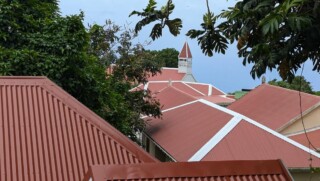New Discovery: Leader of Statia Slave Revolt made it to Freedom
ORANJESTAD- St. Eustatius’ slave revolt of 1848 was an unknown part of the past of the “Historical Gem of the Caribbean” until it was brought to the attention of the wider public by island historian Walter Hellebrand who is now standing as a BBB candidate for the Second Chamber elections of the Dutch kingdom on 22 November.
A new discovery in the National Archives of Aruba now shows that one of the leaders of the revolt lived to see the abolition of slavery that he fought for.
Hellebrand reconstructed the events of the day of the revolt, 12 June 1848, and found the names of the six leaders with additional help of St. Maarten archivist, the late Alfonso Blijden: Thomas Dupersoy – a free man of mixed descent – and Abraham, Oscar, Prince, Joseph and Valentine who were enslaved workers.
After the revolt was bloodily suppressed with at least six freedom fighters killed, the six leaders were banned from the island, with the enslaved being sent to Curaçao and Aruba. Hellebrand was recently informed by Johny van Eerden of the Aruba National Archives that he found Valentine listed in the ‘Register of Enslaved to be Emancipated on Aruba’ that was put together in preparation of abolition on 1st July 1863. On the Papiamento speaking island, his name had been adapted to Balentien, with the last name Simon added. That could be a Papiamento adaptation of Simmons. He is listed as being 36 years old. Hellebrand: “That corresponds with Valentine in the Slave Register of St. Eustatius who was registered as being born in 1827.” In the Aruba slave register, his mother is listed as Betsy. Valentine’s “owner” was Charles Mussenden, a member of one of the largest slave owning families on St. Eustatius.
In the register of births, deaths and marriages of Aruba, his passing is recorded on 9 July 1877. “That means he stayed on Aruba and lived for 14 more years in the freedom that he fought for.”
Hellebrand first shared the story of the revolt with the staff of the St. Eustatius Historical Museum in 2013, and made it the topic of his keynote address for the Emancipation Day celebrations in 2017. He has since written several articles on the subject and when the local government in 2017 asked for his input on a new National Holiday for St. Eustatius, he suggested 12 June, the date of the Statia Slave Revolt.
Completing the picture
“It is great to see that once the story was out there, historians on other islands have been able to make discoveries that are now helping to complete the picture,” Hellebrand commented. “It is also highly commendable that the local government this year on 12 June formally celebrated the courage and sacrifice of the Statia freedom fighters of 1848.”












